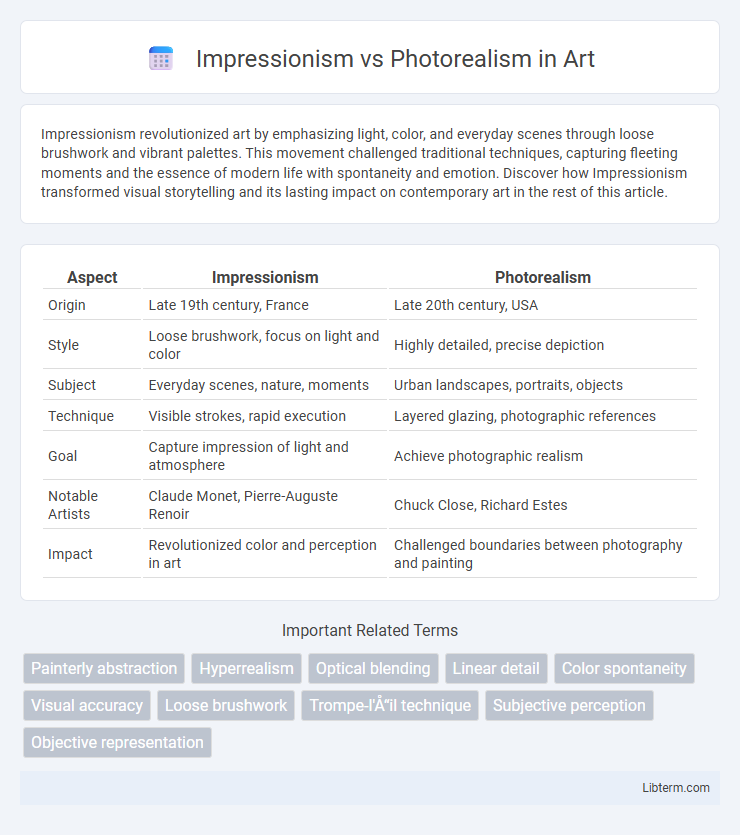Impressionism revolutionized art by emphasizing light, color, and everyday scenes through loose brushwork and vibrant palettes. This movement challenged traditional techniques, capturing fleeting moments and the essence of modern life with spontaneity and emotion. Discover how Impressionism transformed visual storytelling and its lasting impact on contemporary art in the rest of this article.
Table of Comparison
| Aspect | Impressionism | Photorealism |
|---|---|---|
| Origin | Late 19th century, France | Late 20th century, USA |
| Style | Loose brushwork, focus on light and color | Highly detailed, precise depiction |
| Subject | Everyday scenes, nature, moments | Urban landscapes, portraits, objects |
| Technique | Visible strokes, rapid execution | Layered glazing, photographic references |
| Goal | Capture impression of light and atmosphere | Achieve photographic realism |
| Notable Artists | Claude Monet, Pierre-Auguste Renoir | Chuck Close, Richard Estes |
| Impact | Revolutionized color and perception in art | Challenged boundaries between photography and painting |
Origins and Historical Context
Impressionism emerged in the late 19th century France, characterized by artists like Claude Monet who sought to capture fleeting light and natural scenes through loose brushwork and vibrant colors. Photorealism developed in the late 1960s in the United States, influenced by the rise of photography and technological advancements, with painters like Chuck Close emphasizing meticulous detail and clarity to replicate photographic images. Both movements reflect shifts in artistic focus: Impressionism reacted against traditional academic painting by emphasizing perception and atmosphere, while Photorealism responded to modern media by embracing hyper-realistic representation.
Defining Characteristics of Impressionism
Impressionism emphasizes loose brushwork, vibrant color palettes, and the capture of light and movement to convey an overall impression rather than precise detail. This art movement often depicts everyday scenes with a focus on atmosphere and momentary effects, employing short, broken strokes to simulate reflected light. The style contrasts sharply with Photorealism, which aims for meticulous accuracy and clarity resembling high-resolution photography.
Hallmarks of Photorealism
Photorealism is characterized by incredible attention to detail, aiming to replicate photographs with precise accuracy, often highlighting reflections, textures, and lighting effects with meticulous care. Unlike Impressionism, which emphasizes loose brushwork and capturing fleeting moments with vibrant colors and subjective interpretation, Photorealism demands technical skill to produce images that appear as sharp and clear as real-life photographs. Key features include smooth surfaces, indistinguishable brushstrokes, and an emphasis on everyday scenes rendered in hyper-realistic fashion.
Artistic Techniques Compared
Impressionism employs loose brushstrokes and vibrant colors to capture the fleeting effects of light and atmosphere, emphasizing the artist's perception over precise detail. Photorealism, in contrast, utilizes meticulous techniques and fine brushwork or airbrushing to replicate photographic clarity, focusing on exactness and surface texture. These distinct artistic techniques highlight Impressionism's expressive interpretation versus Photorealism's commitment to objective visual accuracy.
Influential Artists in Each Movement
Claude Monet and Edgar Degas significantly shaped Impressionism by emphasizing light, color, and brushstroke techniques that capture fleeting moments. In contrast, Chuck Close and Richard Estes drove Photorealism with their meticulous attention to photographic detail and precision, rendering subjects with striking clarity. These artists' distinct approaches underscore the fundamental divergence between Impressionism's emotional expression and Photorealism's visual accuracy.
Philosophical Approaches to Representation
Impressionism embraces the transient effects of light and color, aiming to capture the artist's sensory experience and emotional response rather than precise details. Photorealism, grounded in a commitment to exactness, seeks to replicate reality through meticulous attention to detail, challenging the viewer's perception of photography versus painting. These contrasting philosophies reflect broader debates on subjectivity and objectivity in art, where Impressionism prioritizes perception and emotion while Photorealism emphasizes accuracy and technical skill.
Impact on Viewers and Art Criticism
Impressionism evokes emotional responses through loose brushwork and vibrant colors that capture fleeting moments, often leaving interpretation open to viewers. Photorealism impresses audiences with its meticulous detail and accuracy, challenging perceptions of reality and technical skill. Art critics debate Impressionism's creative expressiveness versus Photorealism's precision, highlighting differing values in artistic intent and viewer engagement.
Influence on Contemporary Art
Impressionism's emphasis on light, color, and capturing fleeting moments revolutionized contemporary art by encouraging experimentation with perception and brushwork, influencing movements like abstract expressionism. Photorealism, in contrast, pushed the boundaries of realism through meticulous detail and technical precision, inspiring artists to explore hyperrealistic techniques and challenge the distinction between photography and painting. Both movements expanded artistic possibilities, shaping how contemporary artists approach representation and visual truth.
Major Works and Masterpieces
Impressionism's major works like Claude Monet's "Impression, Sunrise" and Pierre-Auguste Renoir's "Dance at Le Moulin de la Galette" emphasize light and color to capture fleeting moments. Photorealism highlights meticulous detail and realism, with key masterpieces such as Chuck Close's "Big Self-Portrait" and Richard Estes' urban scenes that resemble high-resolution photographs. These groundbreaking pieces define each movement's distinct approach to representing reality and perception.
Legacy and Continued Relevance
Impressionism revolutionized art by capturing light and movement with loose brushwork, influencing modern visual culture and inspiring contemporary artists to explore perception and emotion. Photorealism, emerging in the late 20th century, challenged artistic conventions through meticulous detail and precision, advancing discussions on reality and representation in art. Both movements maintain continued relevance by shaping artistic techniques, impacting digital media, and engaging audiences in ongoing dialogues about authenticity and artistic interpretation.
Impressionism Infographic

 libterm.com
libterm.com